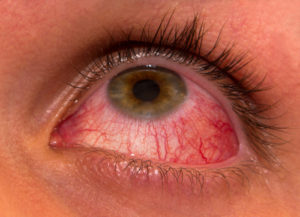 Uveitis is inflammation involving specific parts of the eye. The uvea is composed of the:
Uveitis is inflammation involving specific parts of the eye. The uvea is composed of the:
- Iris – the colored portion of the eye forming the pupil
- Ciliary Body – a very sensitive tissue which makes aqueous humor
- Choroid – one of the deeper layers of the retina.
Arthritis is a common type of inflammation limited to our joints. Inflammation is very difficult to conceptualize, but think of uveitis as arthritis of the eye.
Types of Uveitis
Inflammation of any of these areas constitutes uveitis and there are given specific names referring to the specific location of the uvea involved. For instance;
- Anterior uveitis is limited to inflammation of the iris alone or both iris and ciliary body, both are located in the anterior portion of the eye
- Intermediate uveitis is limited to inflammation of just the ciliary body and vitreous gel
- Posterior uveitis involves just the deep layer of the retina and is inflammation of the choroid.
Symptoms
The most common symptoms of ocular inflammation include blurred vision, redness, sensitivity to light and pain. Depending upon the location, the symptoms can vary. For instance, there is usually less pain associated with intermediate and posterior forms.
The iris and ciliary body are very sensitive. Inflammation here can cause significant pain and discomfort. In contrast, there are few nerve endings associated with the choroid, thus, inflammation of the choroid is generally painless.
Complications
Uveitis can cause a variety of complications in the eye including damage and swelling of the cornea, cataracts, increased intraocular pressure, hypotony (low eye pressure) in chronic cases, retinal swelling or even retinal detachment.
Most cases of uveitis are not too severe and do not cause many complications to the eye; however, complete dilated examination is important to be sure.
Causes of Uveitis
There are dozens of associated systemic illnesses associated with uveitis. Most causes of uveitis are not associated with systemic disease. Viral, fungal and bacterial infections can cause uveitis, but the majority of cases the exact cause or association is not known.
Trauma, such as fist or soccer ball to the eye, can cause iritis.
Many patients experience recurrent episodes of the inflammation.
Treatment
Treatment of most cases of iritis involves steroids to reduce the amount of inflammation. Steroids are most commonly given in the form of drops, but in more severe situations, steroid pills or injections are more effective.
Anterior iritis usually responds well to topical drops whereas intermediate and posterior inflammation may require oral treatment or injections.
More severe cases of uveitis may require immuneosuppressive medications.
A retina specialist often takes care of patients with uveitis.
